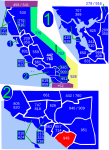Laguna Woods Village
Gated communities in CaliforniaNeighborhoods in Orange County, CaliforniaPopulated places established in 1964Retirement communities

Laguna Woods Village is an age-restricted community for persons aged 55 and over in Laguna Woods, California. The development, formerly known as Leisure World, was developed by Ross Cortese, a former fruit stand owner turned retirement community developer.
Excerpt from the Wikipedia article Laguna Woods Village (License: CC BY-SA 3.0, Authors, Images).Laguna Woods Village
Via Puerta,
Geographical coordinates (GPS) Address Nearby Places Show on map
Geographical coordinates (GPS)
| Latitude | Longitude |
|---|---|
| N 33.617930656341 ° | E -117.71844280207 ° |
Address
Via Puerta 2290
92637
California, United States
Open on Google Maps







